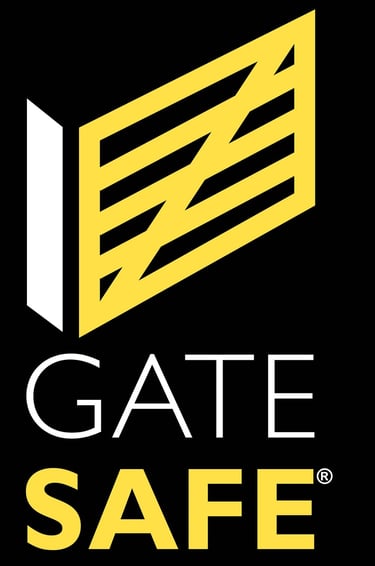
Gate Safe Interview


Who are you and who are Gate Safe?
My name is Richard Jackson and I am the founder of Gate Safe, a national charity which campaigns for the improved safety of all gates, both automated and manual.


Handsam interviews Richard Jackson of Gate Safe, to gain an insight into the valuable work they do around promoting safe gate installation and maintenance and what you can do to make your automated gates safer.
How did Gate Safe come into being?
Gate Safe was set up in 2010 in the wake of the deaths of two young children, in two separate automated gate accidents. Tragically, both children were crushed by an automated gate and both accidents could have been prevented had the gate been correctly installed and maintained with the appropriate recommended safety features. At the time I was the CEO of a business that was involved in the manufacture and installation of perimeter security/access control solutions.
The decision to start Gate Safe was driven primarily by altruistic intentions – as someone who had worked in the industry for over 40 years I felt a sense of duty to step in and do all that I could to ensure that no other families suffered the same devastation. I was called in as an Expert Witness on one case and as part of that process it soon became evident that these accidents were occurring largely as a result of a blatant lack of understanding as to what constitutes a safe and legally compliant installation.
On a commercial level, I was also frustrated that as a company that strived to always put safety at the forefront of any automated gate installation, we were often beaten on price by other businesses whose prices were more favourable simply because they were not incorporating the vital safety precautions required to mitigate against these terrible accidents. As time progressed, Gate Safe became the focus of my attention and I stepped down as CEO to concentrate my efforts on developing the charity.
What services do you provide to schools?
There are a number of services which Gate Safe can provide to schools. First and foremost, our Gate Safe register has become the ‘go to’ for anyone looking to access an installer who has undergone the appropriate IOSH accredited (IOSH is the world’s biggest professional health and safety membership organization) training to understand how to install and maintain an automated gate. We now have over 1,000 installers across the country who have passed our training and who carry the ‘Gate Safe Aware’ badge of assurance.
Secondly, we offer schools the opportunity to use Gate Safe to carry out an independent risk assessment of any gates which might feature on the school site, to identify any possible issues which might compromise the safety of the installation. These assessments are usually conducted on site but we also provide a desk based audit service which is obviously less comprehensive but can be used to highlight any major concerns.
Thirdly, we have introduced a Gate Safe MOT which only Gate Safe Aware installers can operate. The MOT is issued after a gate has been installed or maintained and provides a strong visual reminder as to when the gate was last checked by a professional. Finally, Gate Safe provides plenty of advice on gate safety for schools via its website/a dedicated free guide for schools, which can be downloaded from www.gate-safe.org. We also operate a help line so any schools looking for guidance can call us on 01303 84011
What are the biggest issues regarding powered gates in schools?
It is hard to identify the biggest issues since every gate brings its own set of risks, governed by the individual physical setting/usage of the gate. However, it is fair to say that schools need to be aware of the need for segregation of pedestrian and vehicular traffic; the same automated gate should never be used for both. Observing the required maintenance programme of an automated gate is also key. We recommend gates should be checked every six months – remember an automated gate is defined as a machine, and like a car, requires regular maintenance. I should add that we are also seeing an increasing number of accidents which relate to manual gates, which, if incorrectly designed, installed or maintained, are also capable of inflicting serious injury or worse. Schools need to be aware that they have a responsibility to ensure the safety of ALL gates on the perimeter.

Do you see/hear of many incidents related to powered gates in schools?
We are aware of a number of accidents in schools although thankfully no fatalities to date. However, following a survey by Gate Safe, which found that over 90% of the gates audited failed to meet with the recommended guidance to ensure a safe gate, sadly a serious accident is likely to happen unless schools take the necessary urgent action. Conservative estimates suggest that there are over half a million new gates being installed every year and in total, it is suggested that there are in excess of 3 million gates in existence. If 90% of those are unsafe, it is quite likely that a large proportion of that 90% will be located in the school environment.
Why is it so important to take powered gate safety seriously and what are the consequences of not doing so?
The answer to that is quite simple. Powered gates are capable of inflicting serious injuries and have been responsible for a number of deaths in the UK. Aside from the terrible consequences of a person losing their life or being seriously injured, a school which fails to ensure the safety of its gates may well be found liable for negligence by the courts and following recent precedence, could face fines of up to £80,000, as well as untold damage to its reputation. Just this month, we have seen a jail sentence handed down to an installer who was held responsible for a gate which killed a woman, sending out a clear message that those held accountable for negligence will pay a high price for their actions.
Would a school be liable in the event of a powered gate incident?
Yes, it would. A school is a commercial entity and as such is governed by various legislation such as PUWER, which stands for the Provision and Use of Work Equipment Regulations 1998 (1999 in Northern Ireland). The regulations deal with the work equipment and machinery used every day in workplaces and aims to keep people safe wherever equipment and machinery is used at work. Schools have an innate responsibility safeguard the children in their care.
Should powered gates be regularly inspected and if so, how often and by whom?
Absolutely. Gates should be checked typically every six months but if the usage of the gate is very high, it could be more than that. Gates should be checked by a Gate Safe Aware installer but in between visits, the school should undertake its own risk assessment checks on any gates – automated and manual.
Are there any basic checks schools can carry out when hiring companies to carry out powered gate installations?
We recommend that schools use the Gate Safe register to identify a competent and suitably trained professional to install / maintain gates. Visit www.gate-safe.org and you will find our ‘how to find an installer’ section which will provide a list of installers closest to your postcode.
What risk assessment documentation needs to be in place if you have powered gates at your school?
The risk assessment should always be carried out by a competent contractor (Gate Safe trained) and they should provide a copy of the risk assessment, as well as advising on the additional checks that should be carried out between the regular routine services. How to put the gate into manual operation for example, is something that should always be explained to the school in the event of a power failure.
Office 27, East Moons Moat Business Centre
Oxleasow Rd, Redditch B98 0RE
Phone: 0333 207 0737


